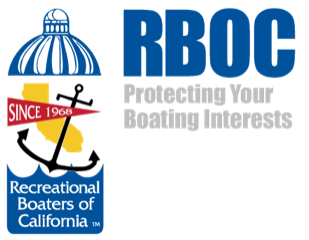RBOC is engaged and is reviewing the impact a new state drought plan may have on boating in the Delta.
The state Department of Water Resources [DWR] has announced that it may be necessary to install emergency salinity control barriers across three channels in the Sacramento-San Joaquin Delta if the weather stays exceedingly dry through spring.
According to DWR, in order to prepare for worst-case drought conditions, and after an extensive environmental analysis and more than nine months of discussion with Delta residents and local water district managers, DWR is seeking a permit from the U.S. Army Corps of Engineers that would allow for the temporary installation of rock barriers at intervals over the next 10 years when saltwater threatens deep intrusion into the Delta.
Also according to DWR, the emergency drought barriers would limit saltwater intrusion, minimizing the amount of water that must be released from upstream reservoirs to repel the salt. Too much saltwater too deep in the Delta can contaminate water supplies for Contra Costa, Alameda and Santa Clara county residents, Delta residents and the 25 million Californians who rely on the Delta-based federal and state water projects.
Here is the link to the Initial Study/Proposed Mitigated Negative Declaration document for the Emergency Drought Barriers Project: click here
Of particular note to boating are the discussions on pages 182 and 183 of this pdf [3-120 and 3-121]:
"Less-than-Significant Impact. The EDB, which could be present from early May to November 15 up to three times in 10 years and potentially in successive years, would restrict recreational boat thru-traffic in Sutter Slough and West False River. Signs would be posted at both entrances to Sutter Slough, informing boaters of the closure and that Steamboat Slough would provide boat passage only for vessels up to 24 feet long and up to 10,000 pounds. Signs also would be posted at both entrances to West False River, informing boaters of the closure and availability of alternative routes (e.g., Fisherman’s Cut or False River east for vessel traffic between the South Delta and the San Joaquin River; and the mainstem San Joaquin River for vessel traffic between Antioch and the eastern Delta).
"Steamboat Slough is navigable by both commercial and recreational traffic, and boat transfer ramps on each side of the emergency drought barrier at this project site would be provided on the east side of the channel. As described in Chapter 2, “Project Description,” two 12-foot-wide gravel roads would be constructed to provide connectivity with Grand Island Road. A State-provided boat tender with a pickup truck and trailer would be present on the apron during daytime hours. When a boat approached, the trailer would be backed into the water, the boat would be placed on the trailer, and it would be driven to the boat ramp on the other side, where it would be placed back in the river. The south ramp would be approximately 90 feet long, and the north ramp would be approximately 120 feet long. Dock anchors (comparable to mooring lines) would be used to stabilize the boat ramps. (The site-specific environmental impacts associated with construction of the two gravel access roads and the boat ramps on either side of the Steamboat Slough rock barrier are evaluated in each relevant topic area in Chapter 3, “Environmental Checklist.”)
"As discussed in Chapter 2, “Project Description,” navigational markers would be used to prevent boaters from entering the immediate construction area, and speed limits would be posted. Safe vessel passage procedures would be coordinated with the U.S. Coast Guard District 11 and California Department of Parks and Recreation’s Division of Boating and Waterways (Cal Boating). An educational program would be offered to inform boaters about the purpose of the project and the expected duration of proposed project activities. The program would include notices in local newspapers and boater publications as appropriate; notices also would be posted at local marinas and boat launches, in the Local Notice to Mariners, and on the proposed project website. Operation of the EDB at all three project sites could occur from early May to November 15 up to three times in 10 years, including potentially in successive years. After the barriers are removed in November, full recreational boat access would resume in each waterway.
"The proposed project would not have a substantial adverse effect on recreation because public notices would be posted, temporary boat transfer ramps would be provided to facilitate navigation, alternate routes would be available, and the proposed project would be a limited size and of short duration. Therefore, the impact would be less than significant."
